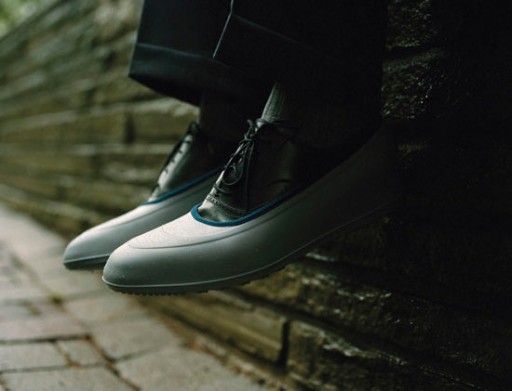 New York, NY – It was a miserable day, cold rain on old snow, and inside Grand Central Terminal, a young man named Justin Levy was sitting high up in an armchair, getting his shoes shined.
New York, NY – It was a miserable day, cold rain on old snow, and inside Grand Central Terminal, a young man named Justin Levy was sitting high up in an armchair, getting his shoes shined.
Subscribe to our Daily Roundup Email
They were good shoes. “They cost me $250,” said Mr. Levy. But they were soaked. Mr. Levy was trying to get them “fixed.” “I ought to buy boots,” he said, “nothing too expensive.”
Why not galoshes?
“Gawhat?” said Mr. Levy. The galosh concept was explained. “You put them on over your shoes?” he said. “OK, maybe.”
The shoeshine stand had a small pile of boxed galoshes for sale: Totes and Tingley’s at about $25. Mr. Levy paid $4 for the shine, glanced at the galoshes—and decided to go look for a taxi.
The galosh lost its allure. Mothers used to yell at kids to wear them. For 40 years, kids have refused. Yet nothing yells galosh like sloppy weather, and this year’s has been so sloppy that galosh visionaries believe April showers may finally be coming their way.
“People don’t wear overshoes unless they absolutely have to,” admits Bruce McCollum, president of Tingley Rubber Co. in South Plainfield, N.J. His grandfather, who sold the first stretch-rubber rubbers 80 years ago, wouldn’t have approved that remark, but he’d applaud Tingley’s latest January-to-January galosh sales: up 65%.
“Overshoes are fresh in people’s minds,” says Tingley’s marketing manager, Jim Towey, who puts nonfarm galosh sales in the tens of thousands. He sees climate-change-conscious wholesalers stocking up for next year. “Weather helps,” Mr. Towey says.
What hurts: sneakers, rubber soles, rubber boots, hiking boots—and dorkiness. The galosh-dork association turns trendy people who wear high-class shoes into puddle jumpers.
Tom Chisena was bucking the trend, and the crowd, in Brooklyn’s slush one day, wearing sneakers under his Tingley extra-wides.
“You get your feet wet, you get sick,” said Mr. Chisena, who is 67 years old and retired. His challenge is getting galoshes on over sneakers. “You bend, yank,” Mr. Chisena said.
In standard practice, a sneakered foot is first placed inside a plastic bag, enabling it to slide into a galosh. Mr. Chisena rejects the technique in favor of a long-term solution: “Put your sneakers into your galoshes once, and keep them there.”
That makes more sense than those clunky hiking boots he sees all over. “Who hikes in the city?” said Mr. Chisena, hiking toward the B train. “It’s like cars. Everybody’s a Pathfinder, an Explorer. I’m walking to the subway.”
While Mr. Chisena’s modern galoshes evolved in America, they’re linguistically Gallic and culturally Slavic.
Russians wear felt valenki indoors. Outdoors, they cover their valenki with galoshi. “The Galosh,” by Mikhail Zoshchenko, is about a man who loses a galosh on a train. Romain Gary wrote of a boy who proves his love for a girl by eating a galosh. In 1972, the Soviet Union deployed a new antiballistic missile: the ABM-1 Galosh.
Galoshes rose to stardom in the U.S. in 1936, when Fred Astaire told Ginger Rogers, “You ought to be wearing galoshes,” just before they sang “A Fine Romance.” But by the 1980s, the galosh was dying. Tingley didn’t retool when shoe styles changed, making things worse. You can’t jam square toes into pointy galoshes.
With unprotected pedestrian activity rife in cities, a galosh revival is afoot. It began in the ’90s when Woody Nash, a New York bond trader, fell down some stairs while wearing “unsightly” rubbers over wingtips. “I thought, there’s got to be a better way,” he says.
He went to Scott Hardy, a Vermont friend, who sewed a nylon upper onto a thick sole and sold it as the Neos. Mr. Hardy says he solved “the problem of making overshoes look good.” So far, though, his big fashion hit is a brand extension for postal workers.
Gary Friedland, a former advertising man in Brooklyn, wasn’t thinking fashion in 2007 when he went into natural rubber dog boots. You don’t buy his brand by the pair; they sell in sets of four to protect from salt.
Pawz is now “the world leader in disposable dog booties,” says Mr. Friedland. He knew he had a winner when he took a prototype for a walk: “People said, ‘Hey! A dog in galoshes! Red galoshes!'”
More dogs are wearing galoshes this year than women are. Women used to carry “drizzle boots” in their handbags. Now they wear boots and carry shoes in their handbags. Rebecca Miller, a Chicago galosh champion, wants women to put the shoes back on. She manufactures the Shuella, a folding plastic “shoe umbrella.”
Swims cost about $95, come in red and orange as well as black, and have a lining that shines your shoes while you walk. They’re on sale in stores like Saks Fifth Avenue and Allen Edmonds, not at shoeshine stands. Mr. Ringdal says, “I want to create some fun.”

And in Skver, they wear it over the Shteevel.
You’re funny, It reminds me of a chelm story where the puretz had new shoes , it was snowing outside. His people suggested the puretz wear boots over his new shoes. The puretz refused because then no one will see his new shoes. So they made holes in his boots so everyone can see them. But then the snow went inside his boots! So they closed his holes with straw. But now again, no one was able to see his new shoes…. So they attached bells to his boots, therefore everyone knew that the Puretz had new shoes…. Had they known about golashes…………..
I remember one time on an escalator when one of my galoshes was gobbled up by the escalator. I gave them up after that.